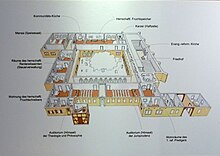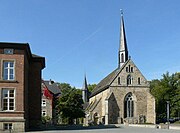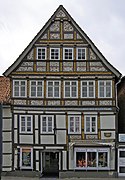University of Rinteln
| Academia Ernestina University of Rinteln |
|
|---|---|
| activity | 1619-1810 |
| place | Rinteln |
| country |
Schaumburg County ( Holy Roman Empire ) |
| Students | at 120 |

The Alma Ernestina (also: Academia Ernestina) in Rinteln in the Weser Uplands was a university founded in 1619 that existed until 1810.
history
The university in Rinteln was founded in 1610 by Count Ernst zu Holstein-Schaumburg in Stadthagen in the former Franciscan monastery , based on a Latin city school that had existed since 1330 and which already had four faculties and a fully academic classroom. In order to be recognized as a fully-fledged university, the imperial privilege that conferred the right to award doctorates was still missing .
In order to obtain the privilege, Ernst had to pay Emperor Ferdinand II 100,000 guilders as a loan, but in return received the title of prince. When applying for the privilege, a move to Rinteln had already been considered, as this city was easier to reach due to its location on the Weser .
The new Alma Mater Ernestina moved into the former Catholic Jakobskloster in Rinteln . Parts of the monastery were redesigned as a "community" (student dormitory), a "Konviktorium" ( cafeteria ) for the scholarship holders and two lecture halls . A library , an instrument room and a pharmacy were set up. The former St. Jakobi monastery church became the university church.
The inauguration took place on July 17, 1621. On this day, the statutes of the university at Bückeburg Castle were drawn up. The expansion and consolidation of the university during the Thirty Years' War could no longer comply with this progressive university constitution . As early as 1623 the city was attacked, conquered and plundered by Duke Christian von Braunschweig-Lüneburg . Most of the students left Rinteln, including the professors, as far as they could. The rector Johannes Gisenius (Giessenius) stayed on site and was able to receive a letter of protection for his university. Despite house arrest and temporary imprisonment, he managed to continue teaching, albeit with great restrictions and considerable difficulties.
According to the edict of restitution of March 6, 1629, the secularization of the Jacobean monastery , which was not carried out until 1560, was to be reversed. Benedictine monks from Hildesheim and Corvey came to Rinteln and took over the university. In 1631 there was a temporary Catholic- theological faculty during the reign of the Catholic Count Jobst Hermann .
The county of Schaumburg was divided after the death of the last Count Otto V shortly before the end of the Thirty Years' War: the northern part of the country came to the County of Lippe , the southern part with the University of Rinteln fell to Landgrave Wilhelm VI. from Hessen-Kassel . Until 1665 Rinteln was jointly owned by Hessen-Kassel and Lippe. Under Landgrave Wilhelm VI. the university was expanded as a Lutheran university.
While the registers of their students ( matriculation ) kept by all universities in the German-speaking area have largely been preserved, there are three exceptions: Mainz , which was lost in wars in 1631/32 and 1944, Trier , where only a few fragments survived, and Rinteln, where fragmentary records of this kind existed. After that, the Alma Ernestina in Rinteln probably never had more than 120 listeners. In addition, the number of students continued to decline after the University of Göttingen was founded . With the end of the Holy Roman Empire in 1803/1806, Rinteln came under the administration of the Napoleonically controlled Kingdom of Westphalia under King Jérôme Bonaparte , where there were other universities in Marburg, Göttingen, Helmstedt and Halle. The universities of Rinteln and Helmstedt fell victim to the administrative reform of 1809 under Minister Johannes von Müller ; the Alma Ernestina was Easter 1810 closed.
Expert opinion in witch trials
The universities of Rinteln, Helmstedt , Rostock and Wittenberg were the leading academic authorities providing expert advice during the witch hunt . The ruling practice at the general German law faculties was quite different. The law faculties of the University of Rinteln and Helmstedt were considered hardliners when it came to the persecution of witches. The professors of the Law Faculty of the University of Rinteln reinforced the witch trials by advising city and local courts throughout the northwest. Between 1621 and 1675 around 400 reports have been handed down that consistently ordered the ruthless persecution of alleged witches and sorcerers.
In 1631 the Rinteln University Printing Works published the Cautio criminalis as an anonymous work, the author of which was soon suspected to be the Paderborn theologian Friedrich Spee von Langenfeld . His new positions presented in it marked the beginning of the fight against the witch trials . The book was the answer to the standard work on the theory of witchcraft by his Rinteln colleague Hermann Goehausen Processus juridicus contra sagas et veneficos from 1630.
University printing house
In 1622 Petrus Lucius (1590–1656) was appointed as a university printer at the University of Rinteln. Between 1627 and 1656, many sermons from Rinteln theologians appeared in his printing house. In 1639 and 1659 he printed the works on Horace by Andreas Heinrich Bucholtz . Until his death, he exhibited his university prints at the Frankfurt Book Fair , most recently a program of 77 books. His son Anthonius Lucius (1635-1704) was a well-known scholar of his time and was from April 4, 1663 to 1670 associate professor at the law faculty in Rinteln.
Buildings
Remaining structures:
- Jakobi-Kirche, church building of the Jakobskloster, in whose rooms the university moved in 1621
- University commission, served as an inn and student residence for the "Academia Ernestina"
- Remaining buildings from the University of Rinteln
Well-known professors
| Surname | Life dates | comment | image |
|---|---|---|---|
| Thomas Abbot | 1738-1766 | Professor of Mathematics and Philosophy. |

|
| Johann Philipp Burckhard Asbrand | 1722-1779 | Professor of the Greek Language. |
|
| Andreas Austen | 1658-1703 | Professor of Greek and Oriental Languages. |
|
| Johann Arnold Barckhausen | 1651-1726 | Professor of Law and Rector. |
|
| Hermann Barkhaus | 1669-1694 | Professor of Morals and Theology. |

|
| Philipp Becker | 1702-1747 | Professor of Law. |
|
| Friedrich Wilhelm Bierling | 1676-1728 | Historian, professor of philosophy and theology. |
|
| Konrad Friedrich Ernst Bierling | 1709-1755 | Professor of Theology. |
|
| Heinrich von Bode | 1652-1720 | Professor of Theology. |
|
| Andreas Heinrich Bucholtz | 1607-1671 | Professor of Philosophy and Poetry. |

|
| Wilhelm Christian Justus Chrysander | 1718-1788 | Theologian, philosopher and polyhistor. |
|
| Heinrich Martin Eccard | 1615-1669 | Lutheran theologian, professor of philosophy, mathematics and theology. |
|
| Johann Eichrodt | 1582-1638 | Professor of Law. |
|
| Johann Hermann Fürstenau | 1688-1756 | Professor of Medicine and Agricultural Economics. |
|
| Johann Friedrich Fürstenau | 1724-1751 | Professor of Anatomy and Surgery. |
|
| Johann Nicolaus Funck | 1693-1777 | Professor of Rhetoric, History and Politics. Rector from 1740 to 1750. |
|
| Franz Giessenbier | 1571-1649 | Legal scholar. |
|
| Johannes Gisenius | 1577-1658 | Professor the Theologian. Representative of Lutheran Orthodoxy. |

|
| Paul Glandorp | 1626-1696 | Professor of Medicine from 1655 to 1665, Rector 1658 | |
| Hermann Goehausen | 1593-1632 | Legal scholar and witch theorist . |
|
| Johann Matthäus Hassencamp | 1748-1797 | Evangelical theologian. Professor of Mathematics, Physics and Oriental Studies |

|
| Johann Otto Henckel | 1636-1682 | Professor of Philosophy, Logic, Metaphysics and Theology. |
|
| Johannes Henichius (Heinichen) | 1616-1671 | Lutheran theologian. |
|
| Johann Kahler | 1649-1729 | Professor of Philosophy and Theology. |
|
| Johann Engelhard Kahler | 1729-1804 | Professor of Theology. |

|
| Wigand Kahler | 1699-1747 | Professor of Mathematics and Theology. |

|
| Henrich Ernst Kestner | 1671-1723 | Professor of Law, Landgrave Councilor. |

|
| Philipp Lohmeier | 1648-1680 | Professor of Mathematics and Physics. |
|
| Johann Peter Lotichius | 1598-1669 | Professor of Medicine. Historiographer and Imperial Poeta Laureate . |
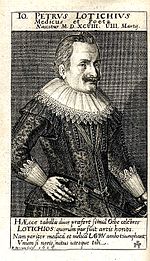
|
| Anthonius Lucius | 1635-1704 | Professor of Jurisprudence. |
|
| Heinrich Majus | 1632-1696 | Professor of Medicine. |
|
| Just Heinrich Mangold | ? -1742 | Professor of Physics and Medicine. |
|
| Francois Martelleur | 1734-1799 | French language teacher. |
|
| Johann Matthias Matsko | 1721-1796 | Professor of Mathematics. |
|
| Balthasar Mentzer the Younger | 1614-1679 | Professor of Theology. |

|
| Eberhard Mesomylius (Mittelmüller) | 1570-1630 | Professor of theologian. |
|
| Johann Daniel Müller | 1721-1794 | Lutheran theologian. |
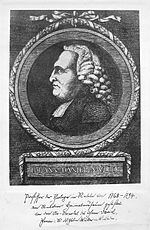
|
| Peter Musaeus | 1620-1674 | Professor of Logic and Metaphysics. |
|
| David Pestel | 1603-1684 | Professor of feudal law and the Codex. |
|
| Friedrich Ulrich Pestel | 1691-1764 | Professor of Ethics and Rights. |
|
| Friedrich Wilhelm Pestel | 1724-1805 | Professor of Ethics and Law, later rector of the University of Leiden . |

|
| Johann Jakob Plitt | 1727-1773 | Professor of Theology. |
|
| Johann Gottfried Schaumburg | 1703-1746 | Professor of Law, later rector of the University of Jena. |

|
| Theodor Schmalz | 1760-1831 | Professor of camera and law, first rector of the newly founded university in Berlin . |

|
| Erasmus Schmidt | 1598-1649 | Professor of Medicine. |
|
| Bernhard Schultze | 1622-1687 | Professor of Politics and Cameralistics. |
|
| Gottfried Schwarz | 1707-1786 | Professor of Theology. |
|
| Johann Gottlieb Stegmann | 1725-1795 | Professor of Philosophy, Experimental Physicist. |
|
| Joshua Stegmann | 1588-1632 | Professor of Theology. |
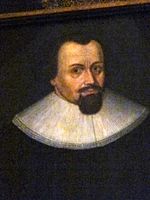
|
| Johann Engelhard Steuber | 1693-1747 | Professor of Theology. |
|
| Ludwig Wachler | 1767-1838 | Professor of Theology and History. |
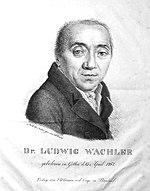
|
| Michael Watson | 1623-1665 | Professor of Physics, Politics and History. |
|
| Julius August Ludwig Wegscheider | 1771-1849 | Professor of Theology and Philosophy. |
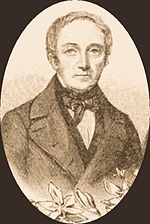
|
| Georg Wilhelm Franz Wenderoth | 1774-1861 | Professor of Medicine. Received the last honorary doctorate from the university. |

|
| Christian Wiederhold | 1775-1832 | Professor of Law, Kurhessischer Minister of Justice, President of the State Ministry. |
|
| Daniel Wilhelmi | 1623-1689 | Professor of Theology. |
|
| Engelbert Wippermann | 1630-1687 | Professor of Law. |
|
| Friedrich Wilhelm Wolfrath | 1757-1812 | Professor of Theology. |
|
Well-known students
The matriculation lists that have been preserved since the Rinteln University was founded are in “Communications from the Central Office for German Personal and Family History, 59th Booklet, The Students of the University of Rinteln, by August Worringer, Leipzig 1939” and in “Schaumburger Studies, Booklet 42 by Gerhard Schormann , Rinteln 1981, Rinteln students of the 17th and 18th centuries ” . The publications are available in the Rinteln city library and in the Bückeburg State Archive , among others .
| Surname | Life dates | comment | image |
|---|---|---|---|
| Johann Christian Wilhelm Augusti | 1771-1841 | Archaeologist and orientalist, professor of theology, rector of the University of Breslau and later of the University of Bonn . |
|
| Christian Heinrich Behm | 1662-1740 | Abbot of the Amelungsborn monastery . |
|
| Ferdinand Beneke | 1774-1848 | Lawyer, attorney and judge in Hamburg . |
|
| Hans Adolph Friedrich von Eschstruth | 1756-1792 | Lawyer, music writer and composer. |
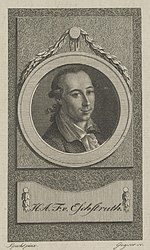
|
| Hulderich of Eyben | 1629-1699 | Lawyer, professor in Giessen and Helmstedt . |
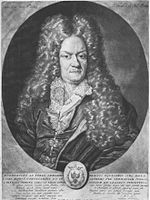
|
| Statius Fabricius | 1591-1651 | Doctor of Theology, Abbot of the Amelungsborn Monastery. |
|
| Bernhard Christoph Faust | 1755-1842 | Doctor and Councilor in Bückeburg . |
|
| Johann Friedrich Fürstenau | 1724-1751 | Physician, received his doctorate in 1745 from his father, J. H. Fürstenau. |
|
| Karl Franz Lubert Haas | 1722-1789 | Historian, theologian and philosopher. |
|
| Georg Hacke | 1626-1684 | Lutheran theologian. Chief Pastor of St. Michaelis in Hamburg. |

|
| Christian Ludwig Henneberg | 1637-1675 | Lutheran theologian and general superintendent Grubenhagen and on the Harz . |
|
| Johann Engelhard Kahler | 1729-1804 | Evangelical theologian. Studied and professor of theology at Ernestina. |

|
| Johann Matthias Korabinsky | 1740-1811 | Teacher, topographer and writer. |
|
| Friedrich Wilhelm Leyser | 1658-1720 | Legal scholar, city counsel of Magdeburg . |
|
| Salomon Friedrich Merkel | 1760-1823 | Lawyer in Kassel. | |
| Friedrich Christoph Müller | 1751-1808 | Theologian and cartographer. |

|
| Gerhard Friedrich Müller | 1705-1783 | Historian, geographer, Russian explorer and explorer. |

|
| Friedrich Wilhelm Pestel | 1724-1805 | Lawyer, Rector of the University of Leiden . |

|
| Theodor Christian Friedrich Raydt | 1768-1833 | Lawyer and Professor. |
|
| Johann Rist | 1607-1667 | Hymn poet and Evangelical Lutheran preacher. |

|
| Franz Karl Schleicher | 1756-1815 | Geodesist, war scientist and university professor. |
|
| Friedrich Wilhelm Strieder | 1739-1815 | Librarian, lexicographer and historian. |
|
| Arnold Dietrich Tidemann | 1756-1821 | Lawyer, Senator and Mayor of Bremen. |
|
| Philipp Johann Tilemann | 1640-1708 | Writer and Reformed theologian. |
|
| Ludwig Wachler | 1767-1838 | Historian, university rector in Marburg and Breslau . |

|
| Johann Dietrich Winckler | 1711-1784 | Lutheran theologian in Hamburg. |

|
| Andreas Wiß | 1788-1816 | Poet, with his exam in April 1810 he was one of the last graduates of the university. |
|
| Hermann Zoll | 1643-1725 | Lawyer, councilor and head of the princely Rinteln government. |
|
literature
- Franz Karl Theodor Piderit: History of the Hessian-Schaumburg University of Rinteln. Pressure and Verlag N. G. Elwert, Marburg 1842 ( digital copy ).
- Edward Schröder: The University of Rinteln. Rinteln 1927.
- Rudolf Feige: The Stadthagen academic high school and the early days of the University of Rinteln. Fritz Seifert bookstore, Hameln 1956.
- Willy Hansel: Catalogus Professorum Rinteliensium. The professors of the University of Rinteln and the academic high school in Stadthagen 1610-1810. (= Schaumburger Studies No. 31). Rinteln 1971.
- Gerhard Schormann : From the early days of the Rinteln Law Faculty. Bückeburg 1977, ISBN 3-924700-06-0 .
- August Woringer: The students of the University of Rinteln (Academia Ernestina). (= Communications from the Central Office for German Personal and Family History 59). Leipzig 1939. (Reprint: Nendeln / Liechtenstein 1980)
- Gerhard Schormann: Rinteln students of the 17th and 18th centuries. (= Schaumburger Studies No. 42). Rinteln 1981, ISBN 3-87085-074-5 .
- Gerhard Schormann: Academia Ernestina: The Schaumburg University of Rinteln on the Weser 1618 / 21-1810. Braun-Elwert, Marburg 1982, ISBN 3-7708-0752-9 .
Individual evidence
- ↑ Text inscription: ERNESTUS, DEI GRATIA, SRI PRINCEPS, COMES HOLSATIAE, SCHAVENBURGI ET STERNBERGAE, ACADEMIAE NOVAE RINTELENSIS FUNDATOR ETC. Aurea Saturno quondam sub rego fuerunt Secula; ceu vatum Musa recenset anus. Cur Virtus, Probitas, Aequum, Rectumque Bonumque. Et IVS et Pietas floruit atque FIDES. HOC DUCE qvando cibos tellus inarata creavit; Et mel at nectar lacque merumque dedit. Pax fuit, haud bellum: nec hiems sed perpetuum ver, Nullus ubique labor, nullus ubique timor.
- ^ Herbert Kater: The statutes of the University of Rinteln / Weser 1621–1809. Latin-German synopsis with additional documents as a special edition Einst und Jetzt 1992, pp. 1–241.
- ^ Rudolf Feige: The academic high school Stadthagen and the early days of the University of Rinteln. Hameln 1956, p. 34f.
- ↑ Michael Trauth: A meeting of science and enlightenment. The University of Trier in the 18th century. Spee Verlag, Trier 2000, p. 15ff.
- ^ Unlike K. Goldmann (edit.): Directory of universities. Neustadt 1967, pp. 311, 355, who complains of "no preserved" registries from Rinteln.
- ^ Friedrich Arnold Brockhaus (Ed.): Literary Conversations-Blatt for the year 1823. Volume 2, Brockhaus, Leipzig 1823, p. 1021.
- ↑ Joachim Woock, Verden history workshop, "... so they suspect stimulated vice ...", The last persecutions of witches in the Swedish duchies of Bremen and Verden, with reference to Schormann, Gerhard: From the early days of the Rintelner Juristenfakultät, Bückeburg 1977 . historicum.net
- ↑ The Eulenburg. University and City Museum Rinteln : witch hunt in Schaumburg , accessed on June 24, 2017.
Web links
- Permanent exhibition on the University of Rinteln in the Rinteln Museum
- Bibliography by the printer Petrus Lucius d. Ä. and his heirs ( Memento from January 10, 2005 in the Internet Archive )
Coordinates: 52 ° 11 ′ 9 ″ N , 9 ° 4 ′ 40.6 ″ E

